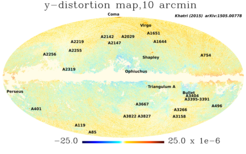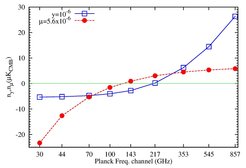New limits on the spectral distortions of the Cosmic Microwave Background
The spectrum of the Cosmic Microwave Background (CMB), the relic radiation from the early Universe, is an almost perfect blackbody. The CMB spectrum was measured with high precision about 25 years ago by the FIRAS experiment on the COBE satellite. The FIRAS experiment could not detect any deviations from a Planck or blackbody spectrum and placed upper limits on the spectral distortions, i.e. the deviation from a Planck spectrum as parameterized by two parameters 'y' and 'μ'.

The y-type distortion is created by Compton scattering of CMB photons by free electrons which are at higher temperatures such as those in the hot intracluster medium (ICM) in the clusters of galaxies. In particular, the y-type distortion is the solution when the energy exchange between the electrons and the photons is very inefficient. For example, in clusters of galaxies only a very negligible fraction of electron energy is transferred to the CMB. But since the electron temperature is many orders of magnitude higher than that of the CMB (1 to 10 million degrees Kelvin vs few degrees Kelvin) the effect on the CMB spectrum is non-negligible and observable.
If the energy exchange from electrons to photons and vice versa in Compton scattering is efficient a new equilibrium can be reached. This new equilibrium solution is not a Planck spectrum any longer, since it was created by adding energy to it; it is a more general Bose-Einstein spectrum which differs from the Planck spectrum by the presence of a non-zero chemical potential. The μ parameter is just the magnitude of this chemical potential divided by temperature, both with units of energy, making it dimensionless.
Such conditions, where the energy exchange between electrons and photons is efficient, happen in the early Universe when the density is much higher and the temperature of both photons and electrons is much higher than the CMB temperature today. Both these distortions were predicted by Sunyaev and Zeldovich already in 1969 and 1970. FIRAS put limits on the average values of these parameters in the Universe to be y<10-5, μ<10-4.
Now 25 years later, the scientists at MPA decided to take another look at these limits in the light of new data available from the Planck satellite and the South Pole Telescope (SPT), both of which have much higher sensitivity than FIRAS but a much smaller number of frequency channels. Unlike FIRAS, Planck and SPT are not sensitive to the absolute intensity of the radiation but measure the variation in intensity as the telescope scans the sky.
Planck and SPT can therefore only give information about the amplitude of the fluctuating part of the spectral distortions with the constant contribution cancelling out. However, this is not a problem, as in the standard cosmological picture, this fluctuating part gives the dominant contribution to the average y parameter. In addition, the μ parameter can fluctuate if there is some new physics which injects energy inhomogeneously in the early Universe at very high redshifts (z > 5x104). One important scenario is the dissipation of primordial sound waves in the presence of primordial non-Gaussianity, which was first suggested by Pajer and Zaldarriaga.

Digging deep into the publicly available Planck maps, Rishi Khatri and Rashid Sunyaev at the MPA were able to put a new, very conservative limit on the average y parameter (from fluctuating portion of y) of y<2.2x10-6 which is a factor of 7 stronger than the COBE-FIRAS limit. This limit was achieved using a new (almost) all sky map of y-distortion calculated with a new component separation algorithm called LIL developed at the MPA by one of the authors (RK). In addition, by combining the y signal detected by the Planck and SPT teams from confirmed clusters of galaxies in both samples, the team was also able to place an absolute lower bound on the average y distortion of y>5.4x10-8 for the first time.
Using the same algorithm LIL they also created a map of the chemical potential or μ parameter placing a upper bound at 10 arcmin resolution of μ<6.4 x 10-6, a factor of 14 stronger than the COBE-FIRAS limit. By cross correlating the μ map with the CMB temperature map provided by the Planck team they were able to constrain the non-Gaussianity to be no larger than of order unity. The particular configuration of non-Gaussianity that is constrained quantifies the correlation between the primordial density fluctuations on extremely small scales, on the order of 1000 parsec, with the very large scales of 1 to 10 giga parsec. The largest scale we can observe is limited by the size of our cosmological horizon. The μ distortion is one of the very few methods which can constrain non-Gaussianity on such a broad range of scales.













